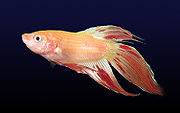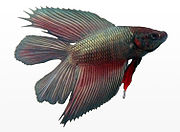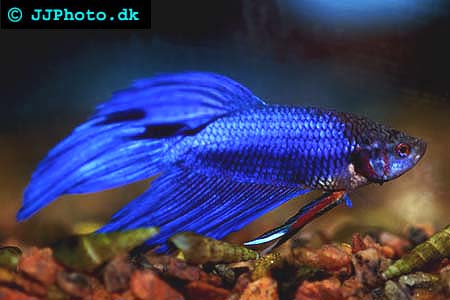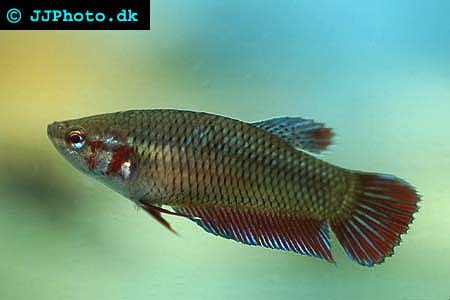The Betta fish (Betta splendens), commonly called a "siamese fighting fish", is one of the most popular species of freshwater aquarium fish. It is native to the Mekong river basin in Southeast Asia and called pla-kad or pla-kat ("Biting Fish") in its native Thailand.
The name Betta (or betta) is pronounced /ˈbɛtə/.[1] That is, the first part is the same as the English word bet. By confusion with the name of the Greek letter beta, the name is often pronounced /ˈbeɪtə/ in American English, and may be misspelled with one t. The name of the genus is unrelated to that of the Greek letter, being derived from ikan bettah, in a local language in Thailand.[2]
B. splendens usually grow to an overall length of about 6.0 cm (~ 2.3 in), though some varieties reach 8.0 cm (3.5 in.) in length. In recent years breeders have been able to create "Giant Bettas" that exceed 8.0 cm (3.5 in.) due to the manipulation of a mutant gene. Although bettas are known for their brilliant colors and large, flowing fins, the natural coloration of B. splendens is a dull green and brown, and the fins of wild specimens are relatively short. However, brilliantly colored and longer finned varieties, such as veiltail, delta, superdelta, and halfmoon have been developed through selective breeding.
The betta is a member of the Gourami family (family Osphronemidae) of order Perciformes, but was formerly classified among the Anabantidae. Although there are nearly 50 other types of bettas, B. splendens is the most popular species among aquarium hobbyists, particularly in the United States.
Rreathing
Like anabantids and all members of the genus Betta, Siamese fighting fish have a labyrinth organ in their heads that allows them to take oxygen directly from the atmosphere in addition to the oxygen taken from water via their gills. Bettas that cannot reach the surface may drown.
Diet
Bettas have upturned mouths and are primarily carnivorous surface feeders. In the wild, bettas feed on zooplankton and the larvae of mosquitoes and other insects, such as flies, crickets, or grasshoppers.[citation needed] Bettas which feed on wide range of foods live longer, have richer colors, and heal fin damage more quickly. Typically, Betta pellets are a combination of mashed shrimp meal, fish meal, brine shrimp, bloodworms, and vitamins. Bettas also will eat live or frozen bloodworms, brine shrimp or daphnia. For variety and fiber, bettas are fed finely-chopped, high-protein vegetables, such as soybeans, green beans, broccoli, corn, and carrots. Some bettas subsist on dried flaked food suitable for tropical fish, because although this feed reduces their coloring, the bettas are able to digest this better than pellets. However, just feeding bettas vegetables alone is not a good idea since they are carnivorous and do best with meat products. Bettas can get constipated when their diet lacks variety. If their stomach looks swollen, feed them food with fiber.
Reproduction and nests
Females have an ovipositor, a small, white 'pearl' at the anus, most visible from below the fish. After mating, females lay egg clutches of approximately 100-500 eggs, rarely over 600 eggs.[citation needed] The female is generally removed from the breeding tank immediately after spawning, as they are known to eat their own fry.
Betta males build bubble nests of various sizes and thicknesses at the surface of the water. During and after spawning, the male uses his mouth to retrieve sinking eggs and deposit them in the bubble nest. After approximately two days the eggs hatch, and after three more they become free-swimming fry; at this point the male is generally removed from the breeding tank to prevent cannibalism and stress to the young. Betta fry are fed infusoria for the first several days, followed by newly hatched brine shrimp or similarly sized food.[3]
| | A red combtail male Betta with a bubble nest. |
B. splendens can be hybridized with B. imbellis, and B. smaragdina.
Colors

A so-called "orange dalmatian" male.
Bettas have been affectionately nicknamed "The Jewel of the Orient" due to the wide range of colors which are produced through selective breeding.
Wild bettas only exhibit strong colors when agitated.[citation needed] However, breeders have been able to make this coloration permanent, and a wide variety of hues breed true. Bettas come in a variety of colors, such as red, blue, turquoise, orange, yellow, white, and green. Most are slightly iridescent, and can appear to change color with different lighting or viewing angle. Breeders have also developed different color patterns such as marble and butterfly, as well as metallic shades such as copper, gold, and opaque.[citation needed]
Breeders around the world continue to develop new varieties. Often, the male species are sold preferentially in stores because of their beauty, compared to the females. Recently, breeders have developed in females the same range of colors previously only bred in males. However, females never develop finnage as showy as males of the same type and are almost always more subdued in colouration.
The gene that makes black bettas is the same one that creates cancer. Therefore, black bettas almost always die earlier than other bettas.
Tail shapes

A metallic, double-tail male Betta
Breeders have developed several different tail shapes:
- Veiltail (non-symmetrical tail, only two rays)
- Crowntail (highly frilled, extended spiny rays)
- Combtail (less extended version of the crown tail)
- Half-moon (large tail fin that forms a 180-degree, or larger, half circle)
- Short-finned fighting style (sometimes called "plakat")
- Double-tail (the tail fin is split into two lobes and the dorsal fin is significantly elongated)
- Delta tail (tail span is less than half-moon with sharp edges)
- Fantail (a rounded delta tail)
Behavior

A male "attacking" and flaring at his reflection in a mirror.
Male and female Bettas flare or "puff out" their gill covers (opercula) in order to appear more impressive, either to intimidate other rivals or as an act of courtship. Females and males will display horizontal bars (unless they are too light a colour for this to show) if stressed or frightened. Females often flare their gills at other females, especially when setting up a pecking order. Flirting fish behave similarly, with vertical instead of horizontal stripes indicating a willingness and readiness to breed. Bettas sometimes require a place to hide, even in the absence of threats. Bettas may set up a territory centered on a plant or rocky alcove, sometimes becoming highly possessive of it and aggressive toward trespassing rivals.
On average, males are more aggressive, though individual females, especially crowntails, demonstrate a wide range in level of aggression. The aggression of bettas has been studied by ethologists and comparative psychologists[4]. Bettas will even respond aggressively to their own reflections in a mirror; use of a mirror avoids the risk of physical damage inherent in actual conflict.[citation needed]
Tankmates
Because of the aggressive nature of the Betta splendens species, tank-mates must be carefully chosen:
Two or more Males: Contrary to popular belief, male betta splendens do not fight to the death in the wild; when one fish has won the fight, the loser retreats to safety.[citation needed] In an aquarium, however, there is no retreat, so the victor fish continues attacking the loser, often resulting in the loser's death, therefore, hobbyists rarely house two male B. splendens in the same tank unless they are (a) separated by a partition, or (b) they are from the same batch of eggs and are immature.
A Male and a Female: In the wild, females stay clear of males, except during mating. When cohabiting in tanks, males might kill females, and are generally kept apart unless (a) they are juvenile siblings, (b) they are breeding, (c) there is a partition, or (d) the tank is large enough for the female to escape attack. Often, before breeding, breeders use a partitioned container to allow female display without risking harm by the male.
Two or more Females: Bettas are not schooling fish, but in a large tank with many hiding spaces, female bettas can cohabit. When two females share a tank, one usually bullies the other; however, four or more females will establish a hierarchy allowing peaceful co-existence. Nevertheless, females living in community must be monitored for aggressive females.
Compatible fish of other species: Hobbyists put betta splendens in tanks with other species after careful research and preparation. Common tankmates include platies (moons), corydoras catfish, and loaches. Females can share a tank with danios, tetras, barbs, and gouramis. Shrimp are popular tank-mates because, provided with sufficient natural plant cover, they keep the tank clean without causing stress to the bettas.[citation needed]
The success of a betta in a community aquarium, however, is largely dependent on the particular betta's level of aggressiveness. Whereas some bettas make wonderful community fish, particularly belligerent or skittish bettas are best housed alone.
Incompatible fish of other species:
- Very small fish (smaller than one inch) may be eaten.
- Fish with long, flowing fins may trigger aggression.
- Slow-swimming fish, e.g. fancy guppies, will be unable to escape bullying.
- Mollies tend to bite the fins off and have been known to kill bettas.
- Schooling fish, especially barbs and certain tetras, will nip at a betta's fins.
- Aggressive fish, such as piranhas, and bluegills, will bully or (if large enough) eat bettas.
- Fish belonging to the same biological family as the betta, such as Paradise Fish and gouramis, may attack or be attacked due to their relatively similar appearance and cross species aggression.
- Goldfish are unsuitable tank-mates because of their great appetites, preference for cold water, and high excretion-rate. Like many tropical fish, Betta splendens might harass and kill small, slow fancy goldfish; in return, goldfish have been known to bite a Betta's tail. Goldfish also can be suitable with bettas. It depends on the level of agression of the betta.
Living conditions
Bettas are often kept in extremely small containers, a practice which many aquarists consider inhumane. This practice is due in part to practical considerations; few pet stores have the space or finances to display a large selection of male bettas except in small containers. However, many inexperienced fishkeepers continue to house bettas in small containers after purchase. A popular misconception is that wild bettas live in very small puddles, and thus are "happier" when kept in cramped conditions. In reality, like any other fish, bettas are healthier, more active and will often grow larger when they are kept in a roomy tank. Aquarists typically recommend that there be at least 1 gallon (3.75L) of water for each cubic inch (16.5cm³) of fish (this is a general estimate; some species may require additional space).
The betta deserves its reputation as a hardy, low-maintenance breed and a good choice for beginning aquarists. However, betta still require appropriate conditions to survive and thrive. The betta is a tropical fish and does best when kept in a tank with a heater (use of heaters is strongly discouraged in tanks under 5 gallons (20L) in size). The ideal temperature for a betta is 78-80°F. Temperatures lower than 76°F (25°C) render the fish lethargic and illness-prone. Betta are capable of jumping from tanks and thus must be kept in a tank with a cover; this cover must not be air-tight, however, as the betta needs to be able to breathe from the surface (especially in a tank which lacks aeration). Also it is recommended by breeders and pet stores alike is that if you are unaware of your water's pH, to use spring water instead. This can be found at virtually any store, or a local spring would be just fine. This helps prevent your betta from getting sick or dying from unbalanced water conditions.
Many beginner's mistakes are perpetuated by the betta's hardiness. Along with believing that cramped spaces are good for bettas, new owners often believe bettas can live for extended periods in foul water, or that a betta doesn't require water changes. Bettas in 1 gallon tanks require 2-3 water changes a week. Bettas in 2 or 3 gallon tanks can make it with weekly water changes and maintain good health for many years. Although small tanks are often sold with filters, tanks with less than 5 gallons do not cycle and bettas still require regular water changes to prevent amonia buildup.
Bettas enjoy plastic plants and small ornaments they can rest on. Many bettas also like ornaments with small openings they can swim in and out of. However, especially with veiltails, plants and ornaments need to be free of sharp edges to prevent the betta from tearing its fins. Because of frequent water changes, most betta owners do not use aquarium gravel in their tanks and bowls. Glass pebbles and marbles designed for aquariums are often popular substitutes.



 Sponge filters can provide a cheap and effective form of biological filtration. Water flows through the airlift tube allowing a colony of beneficial bacteria to grow in the sponge. There is no chemical filtration with this method and the mechanical filtration is very weak. You must do frequent water changes if this is your only form of filtration. Many breeders use the sponge filter in conjunction with a bare bottom tank. After feeding their young fish they will siphon any remaining food to prevent the water quality from detiorating. Frequent water changes are performed because it aids in the rapid growth of the young fish. Fish breeders don't have to worry about mechanical or chemical filtration as much because they are performing frequent water changes.
Sponge filters can provide a cheap and effective form of biological filtration. Water flows through the airlift tube allowing a colony of beneficial bacteria to grow in the sponge. There is no chemical filtration with this method and the mechanical filtration is very weak. You must do frequent water changes if this is your only form of filtration. Many breeders use the sponge filter in conjunction with a bare bottom tank. After feeding their young fish they will siphon any remaining food to prevent the water quality from detiorating. Frequent water changes are performed because it aids in the rapid growth of the young fish. Fish breeders don't have to worry about mechanical or chemical filtration as much because they are performing frequent water changes.

















